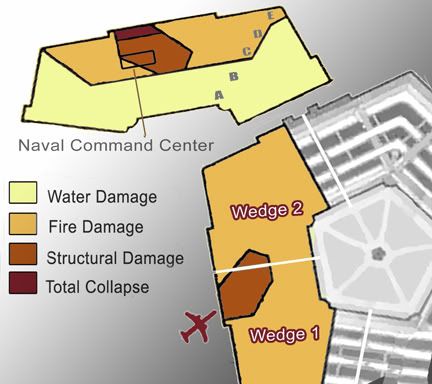Strange then that the plane carrying Raytheon’s anti-radar expert also proved the most effective of the four attack planes at evading radar tracking. As American 77 bore down on Washington, it crossed Ohio and West Virginia unseen by civilian controllers, who thought perhaps it had crashed. For some reason, we’re told, there was no radar at all here, with tracking done only by transponder in a system falsely called “secondary radar.” [2] And the hijacked plane had one of those stupid transponders – as they all seem to – that can be easily disabled by hijackers, as all hijacked flights were on 9/11.

While the other three weaponized airliners were tracked by radar despite the transponder invisibility, Flight 77 was unseen for over half an hour after the hijackers killed its transponder signal. At about 9:25, it entered Washington airspace, which did have radar that picked it up to everyone’s worry. Vice-President Cheney was informed immediately, but twelve minutes later it hit the Pentagon with, allegedly, no warning at all. [3] A spokesman said “the Pentagon was simply not aware that this aircraft was coming our way,” and so obviously had implemented no defense and no evacuation. [4] This despite the just-established protocols for an airliner hit on the building that resulted from a series of drills over the year before 9/11.
And then there’s the Pentagon renovation project (PENREN), a years-long program of updating and remodeling the massive building one wedge, or section, at a time. It just happens that of the five sections, Wedge One, the Navy Wing and home of the US Naval Command, was the first up. Work had begun back in 1998, and a few select tenants moved in as early as February 2001. The grand opening for the wedge was held on March 8, and the first Naval tenants were handed their key a week later, eventually running their Naval Command Center in its brand new office space. [5]
 |
Due to the incomplete nature of the work space, only about 800 people were in the entire wedge one, where there would normally have been about 5,000, further minimizing the death that day. [6] In fact the plane struck just south of the dividing line with wedge two, and pushed fires well into that section; Civil Engineering magazine noted "far less damage and loss of life than the terrorists might have anticipated," and for this credited "the facts that renovation of Wedge 1—an undertaking that substantially fortified that segment—was within days of completion, and that Wedge 2, about to undergo renovation, had been vacated." [7]
Russell Pickering aptly noted of these oddities:
“It's the fact that they hit "near the middle" of the only section that had been "renovated and reinforced with blast resistant windows" where the "staffing levels were lower than usual" on the "other side" of the building from "the top-level military brass, including U.S. Secretary of Defense Donald Rumsfeld" one day before the completion of the renovation on "Wednesday, September 12th, 2001" that has generated some suspicion about the "well-coordinated" attacks.” [8]
For good or ill, this is precisely true.
Sources:
[1] Lecacy.com Tribute: Stan Hall. Tribute submitted by Jane Weiger. Accessed October 9, 2005 at: http://www.legacy.com/Sept11.asp?Page=TributeStory&PersonId=91767
[2] Phillips, Don. “Pentagon Crash Highlights a Radar Gap.” Washington Post. November 3, 2001. Page A06. Accessed November 12, 2004 at: http://www.washingtonpost.com/ac2/wp-dyn?pagename=article&node=&contentId=A32597-2001Nov2
[3] Thompson, Paul. The Terror Timeline. New York Regan Books. 2004. Page 416.
[4] Newsday, 9/23/01, New York Times, 10/16/01. Via: http://www.wanttoknow.info/9-11cover-up10pg
[5] Pentagon renovation details. Accessed November 12, 2005 at: http://renovation.pentagon.mil/projects-W1.htm
[6] See [3]. Page 422
[7] Powell, Ann Elizabeth. “September Eleventh: The days After, the Days Ahead.” Civil Engineering Magazine. November 2001. http://www.pubs.asce.org/ceonline/ceonline01/0111feat.html
[8] Pickering, Russell. "The Pentagon." Pentagon research. http://www.pentagonresearch.com/pentagon.html









1 comment:
Great post, however they have removed the news article regarding the highlighted radar gaps, the title is still there but he story is gone.
i have searched everywhere for another story but can find none
http://www.washingtonpost.com/ac2/wp-dyn?pagename=article&node=&contentId=A32597-2001Nov2
Post a Comment